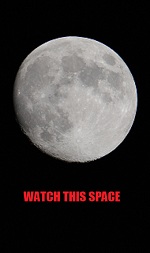 Wow, they never told me that in school!
Wow, they never told me that in school! 
To be fair to my teachers, this was only discovered in 1995 and confirmed in 1997; and I learned of it only yesterday via my buddy Domenick DiMaggio, who was as surprised as I by this revelation. He called attention to the implications of this discovery. Those implications are, indeed, very deep, as I am sure you will understand.
As you may have heard, “Where there is water, there is life.” Not saying that there’s life on the Sun exactly, but it surely means that if water can exist on a star, then water is present pretty much everywhere and those are the implications we are getting at.
It is the feeling and belief around these parts that we should just assume that there is life wherever we look. It’s that way here on Earth; and this evidence makes it all but a foregone conclusion for any location anywhere else, in my humble opinion at least. And yes, I mean not only planets and moons, but asteroids, comets, itty, bitty lumps of rock and ice and yes… quite possibly on the stars themselves.
Below are the abstract of the study and the press release… note that the study is from a biotechnology institution. Life, anyone?
This is exciting!
Here’s the abstract of the study results from the National Center for Biotechnology Information, U.S. National Library of Medicine:
Science. 1997 Jul 18;277(5324):346-8.
Water on the sun: line assignments based on variational calculations.
Polyansky OL, Zobov NF, Viti S, Tennyson J, Bernath PF, Wallace L.
Source
Department of Physics and Astronomy, University College London, Gower Street, London WC1E 6BT, UK.
Abstract
The infrared spectrum of hot water observed in a sunspot has been assigned. The high temperature of the sunspot (3200 K) gave rise to a highly congested pure rotational spectrum in the 10-micrometer region that involved energy levels at least halfway to dissociation. Traditional spectroscopy, based on perturbation theory, is inadequate for this problem. Instead, accurate variational solutions of the vibration-rotation Schrödinger equation were used to make assignments, revealing unexpected features, including rotational difference bands and fewer degeneracies than anticipated. These results indicate that a shift away from perturbation theory to first principles calculations is necessary in order to assign spectra of hot polyatomic molecules such as water.
And here’s the press release from Stanford University:
Researchers Confirm that Water Exists On The Sun
Press Release no. 115 — July 17, 1997
University of Waterloo
WATERLOO, Ont. — An international team of scientists, including a University of Waterloo chemistry professor, has conclusively demonstrated that water (actually steam) does exist on the sun, confirming a breakthrough finding made two years ago.
The team used an innovative method to calculate the water spectrum at sunspot temperatures. The method will be useful in modelling systems with an abundance of extremely hot water molecules, such as forest fires.
The team was led by Oleg Polyansky, a theoretician from Russia’s Institute of Applied Physics; Nizhnii Novgorod, who works with co-researcher Jonathan Tennyson, a physicist at University College, London; and UW chemistry Prof. Peter Bernath, an expert in molecular astronomy. Other team members included Serena Viti, a physicist at University College, London; Nikolai Zobov, a physicist at University College, London; and Lloyd Wallace, an astronomer at Kitt Peak National Observatory, Tucson, Ariz.
In their 1995 study, the team recorded evidence of water — not in liquid form because the sun is too hot, but as vapor or steam — in dark sunspots. The scientists compared the laboratory infrared spectrum of hot water with that of a sunspot.
The water in the sunspots causes a sort of “stellar greenhouse effect” that affects the sunspot’s energy output. Hot water molecules are also the most important absorbers of infrared radiation in the atmospheres of cool stars, such as “variable red giants.”
In their follow-up study, to be published today in the journal Science, the scientists examined the spectrum of extremely hot water such as that found in sunspots and in the laboratory. Hot water has a complicated infrared spectrum characterized by a dense series of sharp absorption lines.
But the transitions that give rise to those lines were not known, until now. The research team carried out a simulation of the infrared spectrum based purely on theoretical calculations, allowing accurate assignments of the absorption lines.
“The detailed interpretation of the infrared spectrum of hot water is one of the important unsolved problems in molecular spectroscopy,” the researchers write in their Science article.
The spectroscopic data will be useful in modelling other systems that contain extremely hot water molecules, such as forest fires and rocket plumes. Spectral analysis captures the characteristic spectra, or wavelength patterns, emitted or absorbed by molecules.
“Our research team solved the problem by doing something completely different,” Bernath said. “Starting with a mathematical model that is progressively improved through perturbation theory doesn’t work for hot water.”
Instead, the team went directly to theory and used the calculated interaction energies of the atoms of water. By using sophisticated variational calculations of energy levels, the researchers predicted the position of transitions that give rise to absorption lines.
“The calculations were so good that they were close enough to the observations for us to make sense of the spectrum,” said Bernath, who led the team that carried out the laboratory spectroscopy. Spectroscopy is the study of the interaction of light and matter.
Contact: John Morris, UW News Bureau, (519) 888-4567, ext. 6047 Prof. Peter Bernath, (519) 888-4567, ext. 4814
Wow!
And yowza, folks, as a bonus for reading this far it can be reported that a team using The National Science Foundation’s Very Large Array found in 1991, (and again in 1994), that Mercury has water, too! Whee!
Here is their summary of the study:
The Discovery of Water Ice on Mercury

Mercury, the innermost planet of our Solar System, is less than half as distant from the Sun as the Earth. Because of this proximity, parts of Mercury’s surface are heated to temperatures nearing 425 degrees Celsius (800 degrees Farenheit). Thus, it was long considered one of the least likely places to find ice.
Though Mercury is one of Earth’s closest planetary neighbors, we know less about it than we do many of the more-distant planets. In 1974 and 1975, the Mariner 10 spacecraft made three passes by Mercury, sending back photos of 45 percent of the planet’s surface. The rest of Mercury is little known, however, so ground-based observers continue to study the planet.
In 1991, planetary scientists Duane Muhleman and Bryan Butler from Caltech and Martin Slade from the Jet Propulsion Laboratory, studied Mercury using a radar system consisting of a 70-meter (230-foot) dish antenna at Goldstone, CA, equipped with a half-million-watt transmitter, and the VLA as the receiving system. The beam of 8.5-GHz microwaves sent from Goldstone bounced off Mercury and was collected at the VLA to produce a radar image of the planet. The researchers used the Goldstone-VLA radar system to look at the side of Mercury that was not photographed by Mariner 10.
The resulting radar image, shown here, contained a stunning surprise. In this image, red indicates strong reflection of the radar signal and yellow, green, and blue, progressively weaker reflection. The bright red dot at the top of the image indicates strong radar reflection at Mercury’s north pole. In fact, it resembles the strong radar echo seen from the ice-rich polar caps of Mars.
“Normal” ice, such as that found on Earth, absorbs radio waves, but ice at very low temperatures is a very effective reflector of radio waves. The strong reflection seen on Mercury is too large to be caused by a momentary “glint” off a crater wall, and when studied in more detail shares the characteristics of reflections from the water ice seen on Mars and the icy moons of Jupiter.
Scientists now believe that the ice resides on the floors of craters at Mercury’s north pole, where it can remain permanently shaded from the Sun and reach temperatures as low as 125 degrees Kelvin (-235 degrees Farenheit).
The VLA, with its great angular resolution, or ability to see fine detail, was crucial to this discovery. It was able to provide sufficient detail of small regions (down to 100 meters in this observation) to reveal the ice reflections. Other analytical capabilities of the VLA helped to further confirm the discovery. In 1994, the same observing team discovered a similar radar reflection from Mercury’s south pole. In sum, the VLA’s capabilities provided major new insight into the nature of this planet.
Good gracious.
Peace.




























































 What’s All This, Then? is copyright © 2009 to the present by Ignatius F Makarevich - All rights reserved worldwide.
What’s All This, Then? is copyright © 2009 to the present by Ignatius F Makarevich - All rights reserved worldwide.


